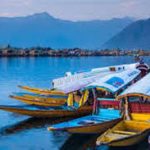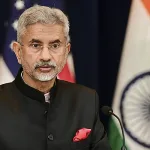Sometimes all it takes for a nation state to realize its comprehensive national power (CNP) is by default. Many a times long standing projects for national progress are stalled by its own self-imposed ‘moratoriumon restraint’ for the sake of maintaining good neigbourly relations. Well the same gets evaporated by unilateral decisions on account of actions inimical to national interests by neighbouring countries.
The mayhem perpetrated at Pahalgam on 22 April 2025 by our western neighbour opened the flood gates for the Indian government to bite the bullet and finally put to rest the much debated and controversial IWT ( Indus water treaty) , till the time Pakistan came to its senses and stopped cross border terrorism. Though reams of paper having been written and much debates plus thumping of tables happening in the national parliament of India for finally calling the bluff of Pakistan; what most of us missed was the pro side of abeyance of IWT.
The simultaneous & singular act of GOI for reviving moribund hydel projects in the former state of Jammu &Kashmir which were held captive & hostage to the evil machinations as a fall out of technical mumbo-jumbo forwarded by Pakistani delegations over the last 4 (four ) decades has been a booster shot not only in the arm of J&K but also for India.
The country has belatedly realized the futility of getting shackled in its own creations on account of express magnanimity shown to its western neighbour(Pakistan) on IWT without a modicum of quid pro quo for the last 6 ( six ) decades. But no longer now. The decision to revive ‘SawlakoteDam’ few days back by the GOI is a pointer in this direction which has been dealt by me in subsequent paragraphs.
For the general information of the readers of this article of mine, let it be known that as on today there are 12 ( twelve) hydel projects in J&K of various capacities which are directly dependent on river Chenab and its various tributaries. Incidentally this is one of the rivers under the ‘Western River System’ as envisaged under the IWT with the other two massive rivers i.e. Indus and Jehlumtoo forming part of the same water treaty on whose waters Pakistan has overriding rights for their usage.
Almost all the three rivers have many stalled hydel projects on account Pakistani intransigence as stated by me earlier thereby overall ballooning India’s water& power burden. For the sake of this write up I am taking only river Chenab and the projects on it as a template to draw lessons which are a direct consequence of putting the IWT under abeyance.
Just to give readers a hang of some of the hydel projects, their overall storage capacity as well as the power generation which are dependent upon river Chenab and its tributaries –
- Total annual flow of water of river Chenab as per the IWT—26.5 MAF ( Million acre feet).
- Water being diverted of river Chenab to Pakistan till abeyance of the IWT—23 MAF.
- Salal Dam—Live storage –0.01 MAF( Milion acre feet) . Type—Run of the river. Power generation—690 MW.
- Baghlihar Dam—Live storage—0.025 MAF.Type—pondage.( temporary storage for daily power generation. ) Power generation –900 MW
- DulHasti Dam—Live storage—negligible—0.005 MAF. Type—Run of the river. Power geneertion-390 MW
Upcoming projects ( under construction / Stalled partially )
- PakalDul( tributary of Chenab) .Live storage—0.087 MAF. Power generation—1000 MW.
- Kiru Dam—Live storage—0.034 MAF—Run of the river project. Power genertion—624 MW.
- Kwar Dam—Live storage—0.005MAF.—Run of the river project. Power generation—540 MW.
- Ratle Dam—0.001 MAF—Run of the river project. Power generation—850 MW.
- Sawlakote Dam—Storage ( over 530 million metric cube ) –Power generation –1856 MW.
- Total live storage of water inclusive of all projects –0.18 MAF. Rest of the water flows down to Pakistan.
- Total power generation of the above hydel projects—6850 MW.
Thus a cursory glance of the above depict that almost all of them are typical ‘Run of the river’ projects with power generation as their sine quo non and not irrigation being their centrality of construction. Last but not the least I am taking some of the above mentioned projects for this article as a case study so as to explain the pros of putting in abeyance the IWT and how Jammu & Kashmir as such can progress from a ‘Power deficiency’ to ‘power surplus’ status.
Originally conceived in the decades of 1960s, Sawlakot hydel project had the capacity of generating 1,856 MW of power designed on the concept of ‘Run of the river’ implying that it had little storage or pondage capacity. But it came under the cross hairs of Pakistani technical observations of violating the IWT which was just a red herring and nothing else.
Sawlakote dam with a height of 192.5 meters and a sizable reservoir (over 530 million metric cube) was viewed by Pakistan as exceeding these limits. It consistently lodged formal objections and pursued arbitration over the above facets. Thereafter Pakistan ran arbitration over hydropower parameters and storage control of this particular project.
On the Indian side the hurdles faced were regarding land acquisition in around 13 villages, relocation of an army transit camp in Ramban district and complex compensation and rehabilitation arrangements. Numerous red-tape approvals including forest clearance for nearly 847 hectares and environmental impact assessments were necessary before construction could begin. Multiple permissions such as exemption from comprehensive impact studies ( CIA/CCS) were delayed as decision makers debated whether to reveal sensitive hydrological data potentially usable by Pakistan.
Negotiations were handled through the Permanent Indus Water Commission and when unresolved went to neutral experts thus further delaying the take off. But with the same project now coming under the ambit of ‘Project of national importance’ as well as getting cleared from the highest echelons of GOI, the NHPC( National Hydroelectric Power Corporation) has floated international tenders for its construction thus marking the formal restart after decades of delay.
The estimated cost of the project is 22,700 crores , and it will be developed in two phases. As for ‘PakalDul ‘ hydro project based on ‘Marusudar’ river which is a tributary of river Chenab , Pakistan again cited dam’s storage capacity and its height parameters despite India telling the former that this dam was ‘project –compliant’ but to no avail. Leading to a bureaucratic and technical gridlock between the two nations.
As far as Kiru dam on river Chenab was concerned, Pakistan claimed that it violated ‘Freeboard and spillway capacity, pondage( live storage ) beyond permissible limits and finally gated spillways instead of un-gated ones to name a few. Pakistan went a step ahead and claimed that India should do a design review and changes similar to it had carried out to alter Baglihar and Kishan Ganga hydel projects.
Something of a similar nature of objections by Pakistan had stalled the above mentioned projects given by me under the heading –‘Upcoming projects/ stalled projects. It is envisaged that the power so generated by the above projects will be injected into the ‘Northern/ National power grid’ of India to be further distributed to the northern states/ UTs of J&K, Punjab, HP, Haryana etc. But provided all the above mentioned hydel projects are cleared of the bottlenecks.
The moot point over here is that the above power generation is based on all the projects only utilizing their partial share of water that was hitherto available due to non-abeyance of IWT. But now with the IWT under abeyance the full availability of water of river Chenab and its tributaries should be the guiding principle for power generation. This I am sure will spike the power generation in all the projects consequently giving a quantum jump to the power availability as well as power transmission to the ‘Northern grid’ of India as a whole.
It will be prudent to watch how these power projects cum dams on river Chenab if completed will pan out and impact the power scenario thus obtaining in the UT of J&K? As on date J&K is a ‘power deficient’ entity with power requirements peaking during winters firstly due to less amount of water available in the rivers of the erstwhile state during the months from November till March /April consequently less amount of water for power generation.
Secondly power is further impacted due to intense heating requirements as winter progresses in J&K. Data from CEA (Central electricity authority) shows a peak power demand of 3057 MW In February 2025, approximately 3095 MW in March 2025 finally reaching up to 3200 MW in January during the typical ‘Chillan Kalan’ period. Authorities project a demand of 3,556 MW and a total requirement of 22,507 Million units ( MU) for the period of 2026-27.
The installed capacity of existing hydro power in J&K is about 3,540 MW which is just about 24% of the identifiable potential of 14,867 MW ( out of 18,000 MW total potential). This shows that even the 08 ( eight) hydel projects on river Chenab as described by me above are functioning way below their capacity since they are not able to boost up the overall kitty of the UT’s electricity demands. The situation further became dismalwith no guarantee of water of 23 MAF being used by India under the IWT that used to go to Pakistan.
With the scrapping of IWT in all its functionality, this above mentioned ‘so called’ surplus water of 23 MAF too should be now diverted for power generation from river Chenab. It is estimated based on rough calculations that power to the tune of 115 to 116 BU ( Billion units) will be produced from this water which up till now was flowing to Pakistan.
And I am not touching the so called surplus waters from rest of the two western rivers of Indus &Jehlum thus obtainable post abeyance of IWT. A national waste of gargantuan proportions. The above action has the capability to pull out J&K not only from the quagmire of a ‘Power deficient’ status to that of ‘power surplus’ but also significantly contribute to the ‘National/ Northern power grid’ after meeting its domestic demand.
With ‘Sawlakote’ dam now getting a new lease of life after more than 40 long years of getting stuck in the labyrinthine cast by our western adversary , it might not just light up homes in the UT of J&K but may also kick start a whole new phase in India’s long overdue‘water diplomacy’.
The path to righteousness in life though torturous has to be endured as has to be in nation-state’s path to ‘self-actualization’. India belatedly though has finally embarked upon the journey to ‘self –actualization’ by unshackling itself from the confines of IWT—a much path breaking development for future strategists to mull upon.
(The writer is a retired army officer and a regular scribe of Rising Kashmir. He can be approached on his email—[email protected])








